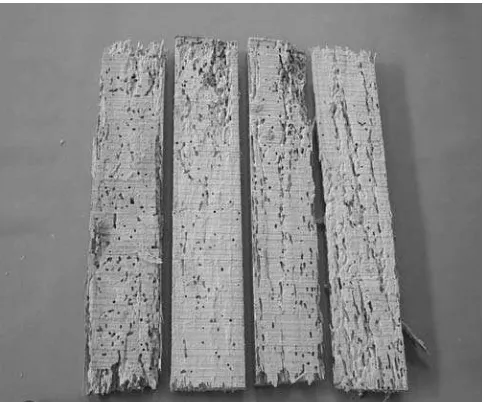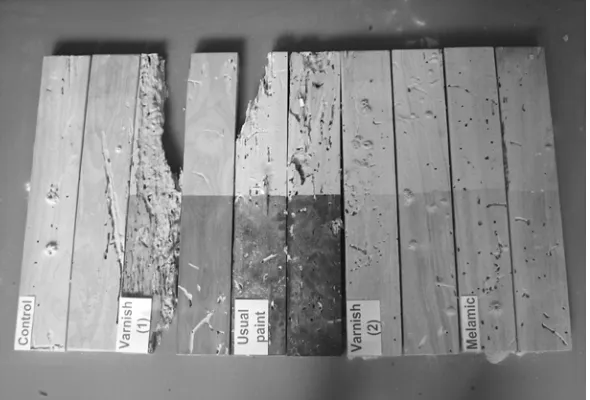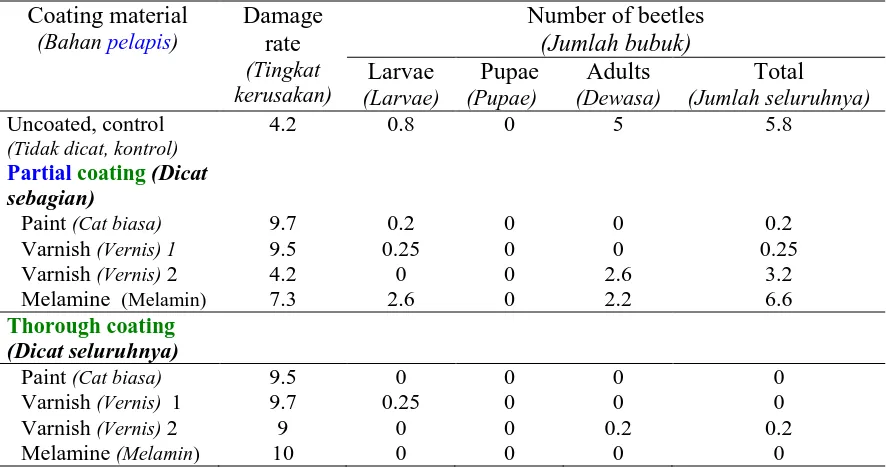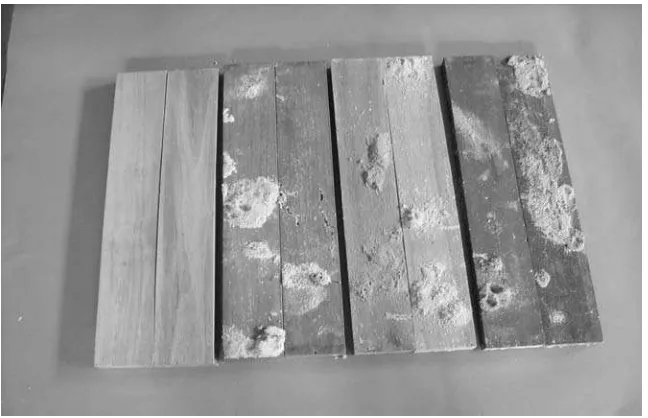POSSIBLE CONTROL OF WOOD DESTROYING INSECTS ON
RUBBER-WOOD USING COATING MATERIALS
Kemungkinan Pengendalian Serangga Perusak Kayu pada Kayu Karet dengan Bahan Pelapis
By/Oleh: Paimin Sukartana
ABSTRAK
Kayu karet (Hevea brasiliensis Muell. Arg.) sangat rentan terhadap serangga perusak terutama bubuk kayu kering Heterobostrychus aequalis Wat., rayap tanah Coptotermes curvignathus Holmgr. dan rayap kayu kering Cryptotermes cynocephalus Light. Untuk menghindarkan serangan serangga perusak tersebut, kayu karet harus diberi perlakuan tertentu. Beberapa percobaan efikasi penggunaan beberapa jenis bahan pelapis (cat), yang banyak tersedia di pasaran, telah dilakukan untuk pencegahan serangan serangga perusak tersebut. Untuk penelitian terhadap bubuk kayu kering, papan kayu karet yang telah kering oven segera dipotong menjadi contoh uji ukuran 10 x 5 x 2,5 cm. Permukaan contoh uji dilabur sebagian atau seluruhnya dengan bahan pelapis. Contoh uji tersebut kemudian
disimpan secara acak di antara tumpukan kayu karet yang telah diserang bubuk kayu kering agar terjadi penularan. Contoh uji yang lain, ukuran 2,5 x 2,5 x 2,5 cm, setelah dilapisi seluruh permukaannya dengan bahan-bahan tersebut diumpankan ke rayap tanah atau rayap kayu kering masing-masing selama 4 dan 12 minggu. Hasil penelitian menunjukkan bahwa pelapisan seluruh permukaan dapat meningkatkan daya tahan kayu karet terhadap serangan bubuk kayu kering. Pelapisan dengan Melamine memberikan hasil terbaik, dalam waktu lebih dari tiga tahun belum menunjukkan adanya kerusakan yang berarti. Namun demikian, perlakuan tersebut ternyata tidak efektif untuk pencegahan serangan kedua jenis rayap tersebut.
ABSTRACT
Rubber-wood (Hevea brasiliensis Muell. Arg.) is highly susceptible to wood destroying insects particularly against powder post beetle Heterobostrychus aequalis Wat, subterranean termite Coptotermes curvignathus Holmgr. and dry-wood termite Cryptotermes cynocephalus Light. The timbers have to be treated to avoid attacking by these insects. Some efficacious experiments using several coating materials that are commercially available had been conducted for controlling those insects. Kiln-dried rubber-wood sawn timbers were immediately cut into test boards of 10 x 5 x 2.5 cm for the beetle test. After thoroughly or partially coated with those coating materials, the test boards were randomly placed amongst rubber-wood timbers being infested by the beetles for contagious infection. Other samples, measuring of 2.5 x 2.5 x 2.5 cm, were coated totally with those coating materials, and then exposed to the either subterranean termite or dry-wood termite species for respectively 4 and 12 weeks. Results showed that the coating treatments increasingly protect the timber against the beetle attack, and coating with Melamine was so far the most effective. There was no significant damage caused by the beetle attack even though the samples have been exposed for more than three years. However those coating treatments were not effective for preventing attack by both termite species.
Keywords: Coating, powder post beetles and termites, damage rate
I. INTRODUCTION
Due to the lack of timber resources, either those from natural or plantation forests, rubber-wood (Hevea brasiliensis Muell. Arg.) harvested from rubber tree plantation has been an alternative source of timber since about three decades ago. This tree plantation was formerly only for the production of latex and woods obtaining from periodical replanting were mostly only for charcoal or firewood (Seng, 1987). Nevertheless since the middle of 1980s it becomes source of timbers for various purposes, particularly for furniture and other wood based industries in Malaysia (Hong, 1996). Commercial value of this timber increases sharply even though it comes only from an agricultural by-product (Killmann and Hong, 2000).
becomes an important timber source for timber industry. Therefore, rubber tree plantation accidentally can be categorized as forest plantation.
However rubber-wood is well known of its susceptibility to wood destroying organisms (Browne, 1961; Norhara, 1981; Sukartana, 1989). Powder post beetles, such as; Heterobostrychus aequalis, Lyctus sp. and Minthea sp., are the most important wood destroying insects infesting dried rubber-wood timbers. These beetles can cause severe damage within about 6-8 months if the timbers are not properly handled or treated (Figure 1). Therefore, success in utilizing this timber definitely depends on how to treat the timber against the insect pests. The treatments are basically intended to preserve the timber so the timber will not be fed by any wood destroying organisms.
Figure 1. Untreated rubber-wood timbers exposed for about 8 months have been totally destroyed by the powder post beetle
Gambar 1. Kayu karet tanpa perlakuan yang dibiarkan sekitar8 bulan telah hancur dicerang bubuk kayu kering
Nevertheless more precaution should be made in utilizing wood preservatives, particularly for residential applications. More environmentally friendlier treatment should be chosen or even without using the toxic chemical if it is possible. This article describes the possibility of controlling wood destroying insects on rubber-wood without insecticide, but using coating materials that are commercially available.
II. MATERIALS AND METHODS
A. Preparation of Wood Destroying Insects
A bulk of kiln-dried rubber-wood sawn timbers was stored for 6-8 months in laboratory until the timbers were naturally infested by powder post beetle H. aequalis. After being infested, which is indicated by extrusion of copious amounts of frass by larvae of the beetles (Creffield and Howick, 1979), the timbers will be ready for use as source of infection.
The subterranean termite specimen, C. curvignahus, was obtained from experimental field in Cikampek through trapping system using a bundle of pine wood boards set in a can container measuring of about 30 cm (diameter) and 37 cm (height) for about four weeks. The container was then carefully transported to laboratory in Bogor for acclimatization or laboratory culturing before the termites were applied. The termites were gently extracted by separating the wood boards for testing purposes.
The dry-wood termite C. cynocephalus was obtained from timbers that have been infested by this wood destroying insect. Fortunately, the laboratory has a warehouse keeping various wood samples collected from throughout the country for years, and many collections are infested by the termite species. The infested wood samples were cautiously split to extract the termites.
B. Preparation of Wood Samples
Because rubber-wood logs are extracted from crop plantation where transportation facilities have been usually well provided, there should not be a significant delay in transporting the logs to the mill. Therefore, it can be sure that the logs coming to the mill are still sound. If the logs are immediately sawn, sound sawn timbers will also be obtained. However rubber-wood logs should be temporarily treated to prevent infestation by ambrosia beetles and wood staining fungi if the logs, due to any reason, have to be kept for more than one month in the field (Sukartana, 1988).
timbers have to be stored in a warehouse that is totally isolated from wood destroying insects. Mosquito screen wire is suitable for sealing any warehouse windows and ventilations to prevent the bostrychid beetle attack coming from outside.
C. Testing against the Powder Post Beetle
These dried timbers were then planed and cut into test boards of 50 x 5 x 2.5 cm (long x wide x thick). The test boards were sanded and then they were entirely or partially
coated with any coating materials that are commercially available in hardware stores, namely; Regular Paint, Varnish (1), Varnish (2), and Melamine. The test boards were then kept randomly amongst infested rubber-wood timbers that have been previously prepared for contagious infestation.
Two sets of samples each with five replicates were provided. One set of the test boards was allowed for at least 8 months so the beetles infesting the samples complete their life cycle (Ho, 1995). These test boards were then inspected superficially to determine any signs of beetle infection. Inspections were continued by splitting the samples to evaluate damage rate in the inner part. Number of larvae and beetles infesting inside the samples was counted and degree of damage on wood samples was recorded according to the modified ASTM (1995). Other set of the test boards was kept for three years to allow the beetle attacks developed further.
D. Testing against the Subterranean Termite Species
E. Testing for Dry-wood Termites, C. cynocephalus
The same size and coating treatments of test blocks as those for the subterranean termite test was provided. Each of the treated test block was placed in a culture bottle, but without sand unlike that for subterranean termite testing. One hundred of pseudo termite workers were introduced into the bottle to allow the termites infest the wood blocks. The tests were kept in a dark room for three months (12 weeks). Data extraction and analysis procedures of this experiment were undertaken similarly as those of C. curvignathus. Five replicates were also prepared.
III. RESULTS AND DISCUSSION
A. Testing against the beetle H. aequalisAttack by the powder post beetles were detected on some wood samples, particularly on controls, after about 4 months of exposure. At this stage, wood powders resulting from boring activities of the beetles that scattered on the surface of the wood samples were found. However, there was no obvious hole on the wood surface. It means that the wood powders were expelled by the beetle activities inside the wood through very small holes made by the beetles or larvae that lived in the wood samples. When dissected, there were many tunnels along with the wood grain which was tightly packed with wood powders.
Figure 2. Damage caused by powder post beetle H. aequalis on totally coated rubber-woods. From left, each consisting of two samples: uncoated (control), coated with Varnish (1), Paint, Varnish (2), and Melamine
Gambar 2. Kerusakan karena serangan bubuk kayu kering H. aequalis. Dari kiri, masing-masing dua contoh: tidak dicat (kontrol), dicat dengan Vernis 1, Cat biasa, Vernis 2, dan Melamin
Figure 3. Damage caused by the powder post beetles on partially coated rubber-woods. Treating arrangements were same as those of Figure 2)
Gambar 3. Kerusakan karena serangan bubuk kayu kering. Susunan perlakuan sama dengan Gambar 2
Further observation, after exposure for about three years, showed that only coating with Melamine still protected the wood samples (Figure 4). During the exposure time, it seemed environmental humidity affected to the samples. Some moulds appeared on most coated samples except on the samples that were coated with Melamine. It means that the humidity might penetrate the coating materials except on the Melamine. The moulds growing on the coated samples possibly facilitated any entry port for the beetles to lay eggs that will hatch to become larvae that will also explore the inner part of the wood samples.
Table 1. Damage rate of rubber-wood and means number of beetles infesting after exposed for about three years
Tabel 1. Tingkat kerusakan kayu karet dan rata-rata jumlah bubuk yang menyerang contoh uji setelah dipaparkan selama tiga tahun
Figure 4. Damage of rubber-wood samples after three years exposure. From left, two samples each, coated with: Melamine, Varnish 1, Varnish 2 and Paint. Samples coated with Melamine were still intact, while others had been badly infested. Frasses shown on wood surface were expelled by larvae or beetles growing inside the samples.
Gambar 4. Kerusakan kayu karet setelah dipaparkan sekitar tiga tahun. Dari kiri, masing-masing dua contoh uji dilapis dengan: Melamin, Venis 1, Vernis 2 dan Cat. Contoh yang dilapis dengan Melamin masih utuh, yang lain telah rusak berat. Serbuk pada permukaan kayu berasal dari aktivitas larva dan bubuk yang berkembang di dalamnya
Meanwhile, Melamine coating might provide better protection to the wood samples against moisture penetration so there was no any part of the samples suitable for laying eggs by the beetles. The coating materials seemingly provided physical barrier or sealant rather than chemical/toxical effect. Unlike to those of the previous ones, these samples were not split to allow the beetles emerged further.
B. Testing against the Termites
Values of percent mortality and wood damage (compare with control) showed any
slight effect of the treatments for preventing wood from attack of both termite species
somewhat toxicity effect of the coating materials as shown also by Nunes et al. (2004) and Sukartana and Balfas (2008). This toxicity effect probably occurred when the termites were previously introduced, but this was not enough for further protection. These facts also agree with some empirical experiences showing that many parts of building structures or furniture that had been coated with those coating materials were still destroyed by the termites (Anonymous, 2002).
Table 2. Percent mortality of termites and damage rate caused by these insects (Tabel 2. Persentase mortalitas rayap dan tingkat kerusakan karena serangannya)
Coating material
C. cynocephalus C. curvignathus C. cynocephalus C. curvignathus
Control (Kontrol) 53.8a 20.8a 4.6 4
Numbers within each column followed by the same letter were not significantly different according to the Dunnett’s analyses, P < 0.05.
1
(Angka-angka pada masing-masing kolom yang diikuti dengan huruf sama tidak berbeda nyata menurut analisa Dunnett, P < 0,05)
Ingredients of the coating materials were not analyzed. It is informed that all coating materials have synthetic components containing volatile organic chemicals (VOCs) that are mostly toxic or even carcinogenic (Anonymous, 2008). These toxic chemicals, nonetheless, might have released to the air so there was no toxical effect enymor to both termite species that were employed in the test.
IV. CONCLUSION
These results demonstrated that the coating treatments were ineffective to protect the timber against either subterranean termite C. curvignathus or dry-wood termite C.
cynocephalus. Most of the coating materials contain volatile organic chemicals (VOCs) that
Conversely thoroughly coating treatments were able to increase protection of rubber-wood timber against attack by the bostrychid beetle, H. aequalis. Among coating materials that were used, Melamine was the most effective for protection the timber. There was no significant attack on the test boards coated with Melamine by the beetles even though the timbers have been exposed for more than three years.
Using coating materials for beetle control might be more expensive than using conventional insecticides. However in term of ecological risk, using of those coating materials are more environmentally acceptable than that of insecticides, even though it is still questioned now because using materials containing VOCs should also be reduced because of the environmental reason (Fonceca, 2004).
Acknowledgements
The author would like to thank Agus Ismanto, Rusti Rushelia and Neo Indra Lelana for their diligent technical assistances.
References
Anonymous, 2002. Dry-wood termites, integrated pest management in the home. Pest Notes, Publication 7440. Agriculture and Natural Resources, University of California: 6 pp.
____________, 2008. Natural paint basics. www.appropedia.org/Natural_paint_basics# Main_Ingredients_of_Paint. Accessed 5 May 2008.
ASTM, American Standard for Testing and Materials, D 3345-74. 1995. Standard method of laboratory evaluation of wood and other cellulosic materials for resistance to termites. Annual Book of ASTM Standard, Vol. 04.09(Wood), reapproved 1992: 430-432.
Browne, F.G. 1961. The Biology of Malayan Scolytidae and Platypodidae. Malay. For. Records No. 22.
Creffield, J.W. and C.D. Howick. 1979. A note on laboratory culture and maintenance of Heterobostryhus aequalis Wat. J. Aust. Entomol. Soc. 18: 137-139.
Fonceca, A. 2004. Environmental management in wood processing industries and the European Legislation on VOC emission control. Proceeds 1st Int. Conf. Environmentally-Compatible Forest Products, 313-324.
Ho. Y.F. 1995. The life cycle of the powder-post beetle Heterobosthrycus aequalis. J. Trop. For. Prods. 1(1): 26-29.
Hong. L.T. 1995. Rubber-wood utilization: a success story. Paper presented at the XX International Union of Forestry Research Organizations (IUFRO) World Congress, Tampere, Finland, 6-12 August 1995.
Norhara Bt. Hussein. 1981. A preliminary assessment of the relative susceptibility of rubber-wood to beetle infestations. Malay. For. 44: 482-487.
Nunes, L., T. Nobre, B. Gigante and A.M. Silva. 2004. Toxicity of pine resin derivates to subterranean termite (Abstract). Managem. Environ. Quality: Int. J. 15: 521-528. Seng, H.K. 1987. Current processing techniques of rubber-wood. Proceeding of the Second
Rubber-wood Seminar. FRIM, Malaysia: 40-48.
Sornuwat, Y., C. Vongkaluang, T. Yoshimura, K. Tsunoda and M. Tatahashi. 1995. Wood consumption and survival of the subterranean termite, Coptotermes gestroi Wasmann using the Japanese Standardized Testing Method and the modified wood block test in bottle. Wood Res. No. 2, 8-13.
Steel, R.G.D. and J.H. Torrie. 1980. Principles and Procedures of Statistics, a Biometrical Approach. McGraw-Hill Book Company, New York.
Sukartana, P. 1988. Pendugaan kepekaan kayu karet terhadap serangan kumbang ambrosia. Jurnal Penelitian Hasil Hutan, Pusat Litbang Hasil Hutan, Bogor. 5(7): 417-419. ___________. 1989. Kepekaan kayu karet terhadap kumbang penggerek. Jurnal Penelitian
dan Pengembangan Kehutanan, Bogor. 5(1): 36-42.
Lembar Ringkasan Abstrak
______________________________________________________________________
Paimin Sukartana (Centre for Forest Products Research and Development)
Using coating materials, namely Varnis 1, Varnish 2, Regular Paint and Melamine, for controling wood destroying insects infesting rubber-wood timbers (Hevea brasiliensis) were described. Totally coating might increase the timber protection against powder post beetle Heterobostrychus aequalis. Best protection was found by coating with Melamine. However no one of the coating materials was effective for protecting the timbers against both subterranean and dry-wood termites Coptotermes curvignathus and Cryptotermes cynocephalus respectively.
Paimin Sukartana (Pusat Penelitian dan Pengembangan Hasil Hutan)




